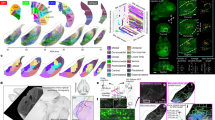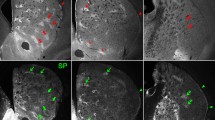Abstract
The striatum (caudate nucleus, putamen and nucleus accumbens) is the main input structure of the basal ganglia. It receives cortical projections from the vast majority of the cortex, as well as from other subcortical structures such as the thalamus and amygdala. Its role in planning, preparation and execution of voluntary movements is known to be fine-tuned by the interaction between projection neurons and interneurons. Since the 1990s, it has been accepted that the proportion of interneurons increases phylogenetically, being about 5% in rodents and 26% in humans. However, these data have not been confirmed with unbiased techniques, such as stereology. In the present report, we have divided the human striatum into functional territories (associative, sensorimotor and limbic) and we have quantified the numerical density of all striatal neurons (using Nissl staining) in each area. Taking into account our past research on the estimation of striatal interneurons, we have calculated the proportion of interneurons in each territory. This value was on average 17.1% for the whole striatum, although interneurons were more abundant in the associative (21.9%) than in the sensorimotor (12.8%) and limbic (11.1%) aspects. Therefore, we demonstrate with unbiased stereology that the overall proportion of striatal interneurons is slightly lower than that reported in previous studies, and that it varies in the functional territories of this structure.





Similar content being viewed by others
References
Arbuthnott GW (2014) Thalamostriatal synapses-another substrate for dopamine action? Prog Brain Res 211:1–11. https://doi.org/10.1016/B978-0-444-63425-2.00001-5
Bernacer J, Prensa L, Giménez-Amaya JM (2005) Morphological features, distribution and compartmental organization of the nicotinamide adenine dinucleotide phosphate reduced-diaphorase interneurons in the human striatum. J Comp Neurol 489:311–327. https://doi.org/10.1002/cne.20616
Bernacer J, Prensa L, Gimenez-Amaya JM (2007) Cholinergic interneurons are differentially distributed in the human striatum. ST-cholinergic interneurons are different. PLoS One 2:e1174
Bernacer J, Prensa L, Giménez-Amaya JM (2012) Distribution of GABAergic interneurons and dopaminergic cells in the functional territories of the human striatum. PLoS One 7:e30504. https://doi.org/10.1371/journal.pone.0030504
Bernacer J, Corlett PR, Ramachandra P et al (2013) Methamphetamine-induced disruption of frontostriatal reward learning signals: relation to psychotic symptoms. Am J Psychiatry 170:1326–1334. https://doi.org/10.1176/appi.ajp.2013.12070978
Carlo CN, Stevens CF (2011) Analysis of differential shrinkage in frozen brain sections and its implications for the use of guard zones in stereology. J Comp Neurol 519:2803–2810. https://doi.org/10.1002/cne.22652
Cicchetti F, Beach TG, Parent A (1998) Chemical phenotype of calretinin interneurons in the human striatum. Synapse 30:284–297
Cicchetti F, Prensa L, Wu Y, Parent A (2000) Chemical anatomy of striatal interneurons in normal individuals and in patients with Huntington’s disease. Brain Res Brain Res Rev 34:80–101
Deserno L, Schlagenhauf F, Heinz A (2016) Striatal dopamine, reward, and decision making in schizophrenia. Dialogues Clin Neurosci 18:77–89. https://doi.org/10.1016/j.siny.2015.10.004
Dombrowski SM, Barbas H (1996) Differential expression of NADPH diaphorase in functionally distinct prefrontal cortices in the rhesus monkey. Neuroscience 72:49–62. https://doi.org/10.1016/0306-4522(95)00539-0
Dorph-Petersen KA, Nyengaard JR, Gundersen HJG (2001) Tissue shrinkage and unbiased stereological estimation of particle number and size. J Microsc 204:232–246. https://doi.org/10.1046/j.1365-2818.2001.00958.x
French SJ, Ritson GP, Hidaka S, Totterdell S (2005) Nucleus accumbens nitric oxide immunoreactive interneurons receive nitric oxide and ventral subicular afferents in rats. Neuroscience 135:121–131. https://doi.org/10.1016/j.neuroscience.2005.06.012
Fudge JL, Kunishio K, Walsh P et al (2002) Amygdaloid projections to ventromedial striatal subterritories in the primate. Neuroscience 110:257–275
García-Amado M, Prensa L (2012) Stereological analysis of neuron, glial and endothelial cell numbers in the human amygdaloid complex. PLoS One. https://doi.org/10.1371/journal.pone.0038692
García-Cabezas M, John YJ, Barbas H, Zikopoulos B (2016) Distinction of neurons, glia and endothelial cells in the cerebral cortex: an algorithm based on cytological features. Front Neuroanat 10:107. https://doi.org/10.3389/fnana.2016.00107
Gerfen CR, Surmeier DJ (2011) Modulation of striatal projection systems by dopamine. Annu Rev Neurosci 34:441–466. https://doi.org/10.1146/annurev-neuro-061010-113641
Goulet-Kennedy J, Labbe S, Fecteau S (2016) The involvement of the striatum in decision making. Dialogues Clin Neurosci 18:55–63. https://doi.org/10.1016/j.siny.2015.10.004
Graveland GA, Williams RS, DiFiglia MDA-A. (1985) A Golgi study of the human neostriatum: neurons and afferent fibers. J Comp Neurol 234 15:317–333
Gundersen H, Jensen E, Kieu K, Nielsen J (1999) The efficiency of systematic sampling in sterology.pdf. J Microsc 193:199–211
Haber SN (2014) The place of dopamine in the cortico-basal ganglia circuit. Neuroscience 282:248–257. https://doi.org/10.1016/j.neuroscience.2014.10.008
Haber SN (2016) Corticostriatal circuitry. Dialogues Clin Neurosci 18:7–21. https://doi.org/10.1164/rccm.200408-1036SO
Hatton WJ, Von Bartheld CS (1999) Analysis of cell death in the trochlear nucleus of the chick embryo: calibration of the optical disector counting method reveals systematic bias. J Comp Neurol 409:169–186. https://doi.org/10.1002/(SICI)1096-9861
Karlsen AS, Korbo S, Uylings HBM, Pakkenberg B (2014) A stereological study of the mediodorsal thalamic nucleus in Down syndrome. Neuroscience 279:253–259. https://doi.org/10.1016/j.neuroscience.2014.08.046
Kawaguchi Y, Wilson CJ, Augood SJ, Emson PC (1995) Striatal interneurones: chemical, physiological and morphological characterization. Trends Neurosci 18:527–535. https://doi.org/10.1016/0166-2236(95)98374-8
Keuker J, Vollmann-Honsdorf G, Fuchs E (2001) How to use the optical fractionator: an example based on the estimation of neurons in the hippocampal CA1 and CA3 regions of tree shrews. Brain Res Protoc 7:211–221
Kjær M, Fabricius K, Sigaard RK, Pakkenberg B (2016) Neocortical development in brain of young children. A stereological study. Cereb Cortex 1–8. https://doi.org/10.1093/cercor/bhw314
Konopaske GT, Dorph-Petersen K-A, Pierri JN et al (2007) Effect of chronic exposure to antipsychotic medication on cell numbers in the parietal cortex of macaque monkeys. Neuropsychopharmacology 32:1216–1223. https://doi.org/10.1038/sj.npp.1301233
Kreczmanski P, Heinsen H, Mantua V et al (2007) Volume, neuron density and total neuron number in five subcortical regions in schizophrenia. Brain 130:678–692. https://doi.org/10.1093/brain/awl386
Kubota Y, Kawaguchi Y (1993) Spatial distributions of chemically identified intrinsic neurons in relation to patch and matrix compartments of rat neostriatum. J Comp Neurol 332:499–513
Lin LC, Sibille E (2015) Somatostatin, neuronal vulnerability and behavioral emotionality. Mol Psychiatry 20:377–387. https://doi.org/10.1038/mp.2014.184
Meyer G, Gonzalez-Hernandez T, Galindo-Mireles D et al (1994) NADPH-d activity in the islands of Calleja: a regulatory system of blood flow to the ventral striatum/pallidum? Neuroreport 5:1281–1284
Oorschot DE (1994) Are you using neuronal densities, synaptic densities or neurochemical densities as your definitive data? There is a better way to go. Prog Neurobiol 44:233–247. https://doi.org/10.1016/0301-0082(94)90040-X
Oorschot DE (2013) The percentage of interneurons in the dorsal striatum of the rat, cat, monkey and human: a critique of the evidence. Basal Ganglia 3:19–24. https://doi.org/10.1016/j.baga.2012.11.001
Pakkenberg B, Gundersen HJG (1997) Neocortical neuron number in humans: effect of sex and age. J Comp Neurol 320:312–320
Parent A, Hazrati LN (1995a) Functional anatomy of the basal ganglia. I. The cortico-basal ganglia-thalamo-cortical loop. Brain Res Brain Res Rev 20:91–127
Parent A, Hazrati LN (1995b) Functional anatomy of the basal ganglia. II. The place of subthalamic nucleus and external pallidum in basal ganglia circuitry. Brain Res Brain Res Rev 20:128–154
Pennartz CMA, Ito R, Verschure PFMJ. et al (2011) The hippocampal–striatal axis in learning, prediction and goal-directed behavior. Trends Neurosci 34:548–559. https://doi.org/10.1016/j.tins.2011.08.001
Petryszyn S, Parent A, Parent M (2017) The calretinin interneurons of the striatum: comparisons between rodents and primates under normal and pathological conditions. J Neural Transm. https://doi.org/10.1007/s00702-017-1687-x (Epub ahead of print)
Prensa L, Gimenez-Amaya JM, Parent A et al (2009) The nigrostriatal pathway: axonal collateralization and compartmental specificity. J Neural Transm Suppl 49–58
Ramón y Cajal S (1917) Recuerdos de mi vida, volumen 2. Historia de mi labor científica. Moya, Madrid
Redgrave P, Rodriguez M, Smith Y et al (2010) Goal-directed and habitual control in the basal ganglia: implications for Parkinson’s disease. Nat Rev Neurosci 11:760–772. https://doi.org/10.1038/nrn2915
Roberts RC, Gaither LA, Peretti FJ et al (1996) Synaptic organization of the human striatum: a postmortem ultrastructural study. J Comp Neurol 374:523–534
Rubinow MJ, Mahajan G, May W et al (2016) Basolateral amygdala volume and cell numbers in major depressive disorder: a postmortem stereological study. Brain Struct Funct 221:171–184. https://doi.org/10.1007/s00429-014-0900-z
Schmitz C, Korr H, Perl DP, Hof PR (2001) Advanced use of 3-D methods for counting neurons [3]. Trends Neurosci 24:377–378
Shepherd GMG (2013) Corticostriatal connectivity and its role in disease. Nat Rev Neurosci 14:278–291. https://doi.org/10.1038/nrn3469
Singh-Bains MK, Tippett LJ, Hogg VM et al (2016) Globus pallidus degeneration and clinicopathological features of Huntington disease. Ann Neurol 80:185–201. https://doi.org/10.1002/ana.24694
Stark AK, Toft MH, Pakkenberg H et al (2007) The effect of age and gender on the volume and size distribution of neocortical neurons. Neuroscience 150:121–130. https://doi.org/10.1016/j.neuroscience.2007.06.062
Straub C, Saulnier JL, Bègue A et al (2016) Principles of synaptic organization of GABAergic interneurons in the striatum. Neuron 92:84–92. https://doi.org/10.1016/j.neuron.2016.09.007
Wu Y, Parent A (2000) Striatal interneurons expressing calretinin, parvalbumin or NADPH-diaphorase: a comparative study in the rat, monkey and human. Brain Res 863:182–191
Yager LM, Garcia AF, Wunsch AM, Ferguson SM (2015) The ins and outs of the striatum: role in drug addiction. Neuroscience 301:529–541. https://doi.org/10.1016/j.neuroscience.2015.06.033
Yin HH, Knowlton BJ (2006) The role of the basal ganglia in habit formation. Nat Rev Neurosci 7:464–476. https://doi.org/10.1038/nrn1919
Acknowledgements
We are indebted to Dr. Elisa Mengual for making possible this research. We are grateful to Pedro García, Beatriz Paternáin and Esther Luquín for technical support, Jose Ullán and María García Amado for supporting microscope setup and stereology, Gonzalo Arrondo, Maite Aznárez and Jose Miguel Carrasco for statistical advice, and Jose Manuel Giménez-Amaya and Lucía Prensa for their contribution to the study of interneurons. We also acknowledge the suggestions of anonymous reviewers.
Author information
Authors and Affiliations
Corresponding author
Ethics declarations
Conflict of interest
The authors declare that they have no conflict of interests.
Funding
The authors have no funding to report.
Ethical approval
All procedures performed in studies involving human participants were in accordance with the ethical standards of the institutional and/or national research committee and with the 1964 Helsinki declaration and its later amendments or comparable ethical standards.
Informed consent
Next-of-kin of the deceased authorized the autopsy and collection of tissue.
Rights and permissions
About this article
Cite this article
Lecumberri, A., Lopez-Janeiro, A., Corral-Domenge, C. et al. Neuronal density and proportion of interneurons in the associative, sensorimotor and limbic human striatum. Brain Struct Funct 223, 1615–1625 (2018). https://doi.org/10.1007/s00429-017-1579-8
Received:
Accepted:
Published:
Issue Date:
DOI: https://doi.org/10.1007/s00429-017-1579-8




